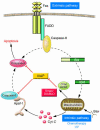Reawakening the cellular death program in neoplasia through the therapeutic blockade of IAP function
- PMID: 16200201
- PMCID: PMC1236691
- DOI: 10.1172/JCI26251
Reawakening the cellular death program in neoplasia through the therapeutic blockade of IAP function
Abstract
Recent studies have shown that members of the inhibitor of apoptosis (IAP) protein family are highly expressed in several classes of cancer. The primary implication of these findings is that the elevated expression of IAPs is not coincidental but actually participates in oncogenesis by helping to allow the malignant cell to avoid apoptotic cell death. This concept, together with the discovery of several IAP-regulatory proteins that use a conserved mode of action, has stimulated a major effort by many research groups to devise IAP-targeting strategies as a means of developing novel antineoplastic drugs. In this Review, we consider the evidence both for and against the IAPs being valid therapeutic targets, and we describe the types of strategies being used to neutralize their functions.
Figures



References
-
- Clem RJ, Fechheimer M, Miller LK. Prevention of apoptosis by a baculovirus gene during infection of insect cells. Science. 1991;254:1388–1390. - PubMed
-
- Salvesen GS, Duckett CS. IAP proteins: blocking the road to death’s door [review] Nat. Rev. Mol. Cell Biol. 2002;3:401–410. - PubMed
-
- Uren AG, Coulson EJ, Vaux DL. Conservation of baculovirus inhibitor of apoptosis repeat proteins (BIRPs) in viruses, nematodes, vertebrates and yeasts. Trends Biochem. Sci. 1998;23:159–162. - PubMed
Publication types
MeSH terms
Substances
Grants and funding
LinkOut - more resources
Full Text Sources
Other Literature Sources
Research Materials

